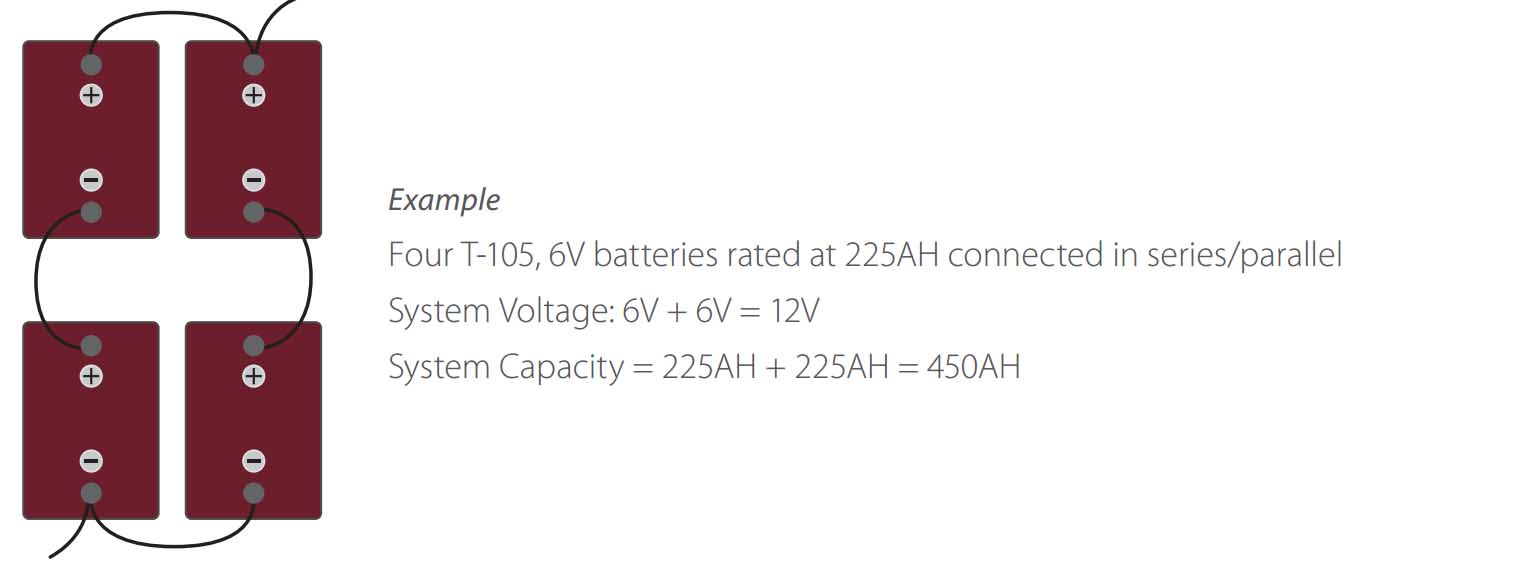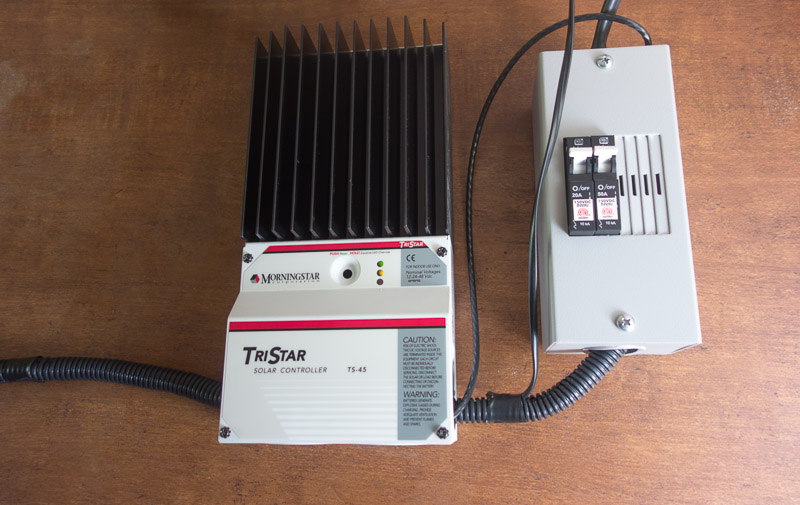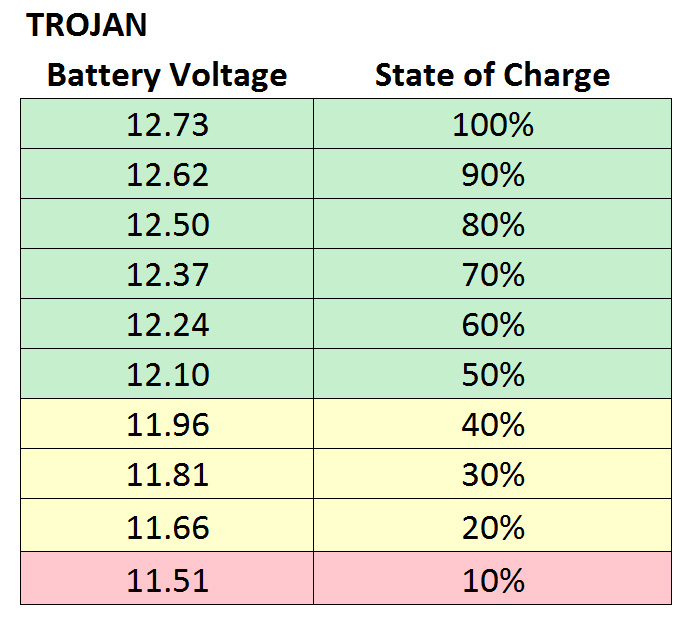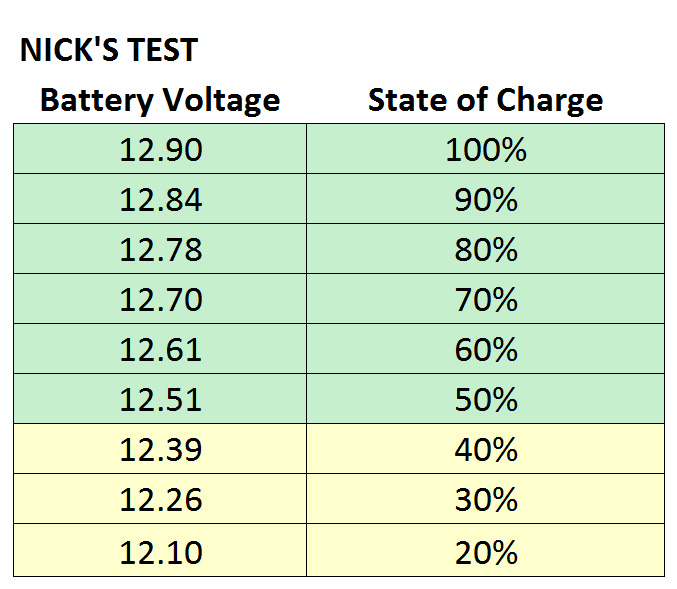THIS MAY BE CONTROVERSIAL
If you own a camper or other recreational vehicle, it probably has a battery or two or at least is set up for a battery.
If you want to utilize a battery in your RV, battery selection is paramount and probably more important is the proper charging settings.
Now if you only camp in campgrounds with umbilical cords to the power grid, you don’t need a battery bank. But I will suggest that you are missing a lot by “camping” in these virtual parking lots. Get thee out into the more wild areas where there is no electric grid. It is called camping, you know – not Parking.
Most campers have a 12-volt electrical system allowing you to run a water pump and other conveniences; none of which are truly required for excellent camping. I camped for decades without electricity – the 120 volt kind or 12 volt kind. But a 12 volt system allows the camper many more options. We can camp in the wild for weeks at a time, and a little propane, a couple of batteries, and a solar system allow us to live a life of luxury far from the grid; and more importantly – away from other people. Our 12-volt system allows us to also use 120 volt appliances like a toaster, blender, big screen TV, and occasionally a microwave!
To be honest, I can’t remember the last time we camped in a campground that had electrical hook-ups; for the past 10 years all of our campers utilized solar systems and since they are stored outdoors all I have to do is check the battery water every month or so. For more information on RV solar systems read about our Milan 26RLS solar system and our Starcraft Meteorite and Fleetwood Niagara solar systems.
The only time we have connected to the grid
- Camping along the Colorado River in the desert heat where daytime temperatures are well above 100 degrees F. At night we run the air conditioner. During the day we are in our boat on the river
- At home when working inside the camper and the temperature is above 100 F, I turn on the A/C
- A few times in campgrounds, we used the camper as a motel room, when we traveled to my son’s track and cross country meets – these were trips where we could not find a remote campground – but this was years ago
WHAT I HAVE LEARNED ABOUT RV BATTERIES
At first I was at a disadvantage with these 12 volt systems because I had spent more than 20 years as an automotive technician. While we cannot change Ohm’s Law or Watt’s Law, we need to learn that automotive systems and RV systems are not created equal. Most automotive charging systems put out between 13.8 – 14.2 volts. A fully charged automotive battery is 12.6 – 12.7 volts. None of this works for a RV, because the batteries are different. After a lot of observation of the electrical systems in the three campers we have owned, and reading the specifications from battery manufacturers, I have learned that RV’s are (or should be) different. One other thing; when I do something, I do it the right way. You may want to take short cuts or save money on your RV, but the right way is still the right way.
Much of the battery information provided in this article came from the Trojan Battery Company. Trojan is well known supplier of quality deep cycle batteries and, more than any other manufacturer I have found, provides a wealth of battery information on their website. This is in contrast with many battery companies whose websites seem to be mostly “smoke and mirrors” when it comes to providing information about their products.
But worse than some of the battery companies that provide little information about their products is the solar and battery equipment industry. For the most part, they don’t provide the correct information about charging deep cycle batteries!!! Not to mention, most of these products can not charge a battery per the battery manufacturers’ specifications.
TYPES OF BATTERIES
Starting Batteries
These are automotive type batteries. Their main function is to supply high amperage for very short periods of time, mostly when starting the vehicle. Once the vehicle is started, the charging system maintains the battery at a full state of charge and provides ample amperage to power all other electrical accessories and the ignition system. The battery is not designed to be discharged frequently. Often a single depth of discharge of 100% will ruin a starting battery, whereas a true deep cycle battery can handle several hundred 100% discharges.
A typical car starter motor draws between 130 – 220 amps. To handle this large draw, starting batteries have many very thin plates that together provide a large surface area. This is contrasted by deep cycle batteries, which have fewer plates that are about twice as thick as those in a starting battery.
Over time, the plates in batteries slowly deteriorate becoming thinner. Although plate size is not the only determining factor in battery life, for RV use you can generally plan on batteries with thicker plates to last longer.
Deep Cycle Batteries
If you plan of living off the battery bank in your RV, then you need a proper battery, which is a true deep cycle battery. Deep cycle batteries are designed to discharge over and over. The main reason they can handle so many discharge cycles is because the plates are normally twice as thick (or more) than a starting battery.

RV/Marine Deep Cycle Batteries
Jack of All Trades – Master of None

The most common battery I see in RV’s are 12-volt deep cycle batteries often called RV/Marine batteries. These are designed to start an RV or Boat and act as a deep cycle battery. This means it needs a larger surface area than a true deep cycle battery. This is accomplished by thinner plates than a true deep cycle (about 60%) less, but more of them. If we keep in mind that thick plates are what make deep cycle batteries ideal for RV applications, then the RV/Marine battery is less than ideal. Given this, two similarly sized system (in amp hours) of two 12-volt Marine/RV batteries connected in parallel are not as good as two 6-volt deep cycle batteries connected in series. The 6-volt batteries have thicker plates. All Group 27 and 31 12-volt batteries I have seen are not true deep cycle batteries.
BATTERY HIEROGLYPHICS
Electricity is electricity. There is no magic here. And electricity can be measured in many ways. There are four common battery measurements, and how a manufacturer communicates a battery’s specification is often a good indicator of what kind of battery it is.
CCA (Cold Cranking Amps): measures the amps a battery can deliver at 0 ° F for 30 seconds and not drop below 7.2 volts. High CCA is important in batteries used to start a car, truck, or RV. It is not important in a deep cycle battery used in a RV, but it can be calculated, but most deep cycle battery manufacturers do not provide a CCA rating. If the rating of a battery is only CCA, then it is a starting battery.
CA (Cranking Amps) or MCA (Marine Cold Cranking Amps): is cranking amps measured at 32 degrees F. This usually indicates the battery is a hybrid used in marine or RV applications.
RC (Reserve Capacity): is the number of minutes a fully charged battery at 80 degrees F will discharge 25 amps until the battery drops below 10.5 volts. Many people feel this is an important measurement – I disagree because very few people will apply a constant 25 amp load to a battery. It is more important to know how many amp-hours of capacity a battery has. To convert the RC rating into amp-hours, divide the RC by 2.4 to approximate amp hours. If the battery rating label includes RC, then it is probably a Marine/RV Deep Cycle Battery.

AH (Amp Hours): Most battery manufacturers state the capacity of a true deep cycle batteries in an amp hour rating usually found on deep cycle batteries. This is the number of amps the battery can provide in a 20 hour period. It is usually stated as, Capacity Amp-Hours (AH) 20-Hour Rate. If the only rating on the battery is AH (Amp-Hours), it is probably a true deep cycle battery and it is the battery you want for your camper.

DEPTH OF DISCHARGE AND BATTERY LIFE

Trojan Battery Company states their true deep cycle batteries can handle of 50% Depth of Discharge cycle about 1,250 times. We try to only discharge our battery bank down to about 80%, which should give us about 3,000 cycles or over 8 years of battery life, assuming we are camping and discharging the battery every single day!
Most true deep cycle batteries are manufactured in a 6 volt configuration. This is handy for several reasons. Batteries can be connected in series or parallel to increase capacity or voltage. For example two T-105 6-volt batteries with a 225 AH (amp hour capacity) can be connected in parallel to create a 6-volt battery bank of 450 AH’s. Connected in series, two of these batteries will create a 12 volt battery bank of 225 AH’s. Four T-105 6-volt batteries connected in series/parallel will create a 12-volt battery bank of 450 AH’s.
Typical 6-volt battery configurations (from the Trojan Battery Website)
Series

Parallel

Series/Parallel

BATTERY CHARGING
If you remember anything from this article, carefully read this section!
As I stated earlier, most automotive alternators put out around 13.8 to 14.2 volts when recharging battery. RV Batteries require a different strategy and values. There are 3 stages plus a special situation called equalization, and Trojan recommends the following at 77 degrees F:
 Daily Charge Rate (1st Stage)
Daily Charge Rate (1st Stage)
This is the voltage that should be applied to the battery until it reaches 90% of charge.
Absorption Rate (2nd Stage)
This voltage is applied until the battery is fully charged. It starts at 14.7 and gradually decreases.
Float Charge Rate (3rd Stage)
This is the rate that is kept constant after the battery is fully charged. Some people call this the maintenance mode.
Equalization Charge Rate
There is one other charging strategy, which is called an Equalization charge. This charge is applied after a battery has been full charged. Trojan recommends this be done if there is a variance of +/- .015 specific gravity between any two cells, or if the specific gravity after a full charge is under specifications. A battery hydrometer is required to measure specific gravity.
Battery Hydrometer
Yes you need a temperature compensated (or know how to convert) battery hydrometer in your toolbox.
It is interesting that Interstate recommends the following:
 This was for all of Interstate’s flooded deep cycle batteries. However their chart does not include their RV/Marine Deep Cycle batteries. Nowhere on their site can I find specific instructions for charging an RV/Marine Deep Cycle battery. However, I did find this statement:
This was for all of Interstate’s flooded deep cycle batteries. However their chart does not include their RV/Marine Deep Cycle batteries. Nowhere on their site can I find specific instructions for charging an RV/Marine Deep Cycle battery. However, I did find this statement:
“Make sure to use a charger specifically designed for deep-cycle or marine/RV batteries. To fully charge a completely discharged battery with a 10-amp charger may take approximately 6-10 hours. Charging time will vary based on size of battery, state-of-charge and size of charger.”
And Exide recommends the following for their deep cycle and marine dual purpose batteries:
All battery manufacturers recommend that the charging voltage be increased or decreased based on the ambient temperature.
TEMPERATURE
Temperature affects battery capacity and it is critical to adjust charge rates based on the ambient temperature.

As ambient temperature increases, so does the battery capacity (amp hours), however batteries discharge faster and battery life decreases. The opposite is true with cold temperatures.
For the RV owner, it is important to know that the charge rate must be increased as the temperature drops, and decreased as the temperature rises. For every 10 degrees below or above 77 F, the charge rate must be adjusted by 0.028 volts per cell. A 12-volt battery or two 6-volt batteries connected in series have 6 cells, meaning the charge voltage needs to be adjusted by 0.17 volts up or down for each 10 degree change in temperature. So Trojan’s charge rate would be:
 In winter, it is not unusual for my solar controller to raise the daily charge rate from 14.8 volts to 15.1 or even 15.5 volts as shown in the pictures below from the TriMetric 2025 battery monitor.
In winter, it is not unusual for my solar controller to raise the daily charge rate from 14.8 volts to 15.1 or even 15.5 volts as shown in the pictures below from the TriMetric 2025 battery monitor.
Trojan recommends avoiding battery charging at temperatures above 120 F, and to never charge a frozen battery.
Trojan also states that:
“The only way that a battery can freeze is if it is left in a state of partial or complete discharged. As the state of charge in a battery decreases, the electrolyte becomes more like water and the freezing temperature increases. The freezing temperature of the electrolyte in a fully charged battery is -92.0F. At a 40% state of charge, electrolyte will freeze if the temperature reaches approximately 16.0 F.”
HOW I GOT LUCKY LEARNING ABOUT RV BATTERIES
When I installed my first solar system, I purchased a Specialty Concepts Mark 15 solar controller as part of a bundled package. It is a Pulse Width Modulated charger, without temperature compensation. It isn’t the best charger and has some deficiencies, but important is the fact that although the factory charge limit was set at 14.4 volts, it could be adjusted higher. Somewhat perplexed by what the battery manufacturers recommended, and what the charge controller recommended, I started to research battery charging strategies. I finally came across a website maintained by Bob Shearer, HandyBob’s Blog. After an email exchange several years ago, Bob encouraged me to set the charger at the Battery manufacturer’s specification. He also highly recommended that I get a solar controller with a remote temperature sensor — one that could set the charge limit to 14.8 volts before temperature correction.

This website may be compensated for linking to other sites for sales of products. As an Amazon Associate I earn a small fee from qualifying purchases at no additional cost to the purchaser.
I highly recommend this website for anyone interested in solar. Bob knows his stuff – actually his is the only solar website with accurate information I have come across in the past 10 years. In addition, Bob seems to be cantankerous, curmudgeonly, and impatient – all of which I find to be excellent character traits.
Will 14.8 or higher charge voltage “boil” my battery?
No, I only need to add water once every couple of months or so. Plus, this is what most battery manufacturers recommend. Who else are you going to believe?
INCORRECT BATTERY STATE OF CHARGE CHART
Below is the typical battery chart I see pasted all over the Internet.
But this chart is incorrect!!
Another chart I often see is from the Trojan Battery website and it is a little better, but doesn’t match my real world experience, although it is more realistic than the chart typically posted on the Internet.

What is interesting is that if you chart the voltage differences there is a distinct pattern… something an engineer would put together — shall we say a theoretical model?
WHAT IS A REALISTIC DEEP CYCLE STATE OF CHARGE TABLE?
Or what would happen if you charged your batteries at 14.8 volts with temperature compensation instead of 14.4 volts or lower?
I propose that you need to charge your battery at the manufacturer’s specification. THIS IS THE ONLY WAY YOU ARE GOING TO PUSH ALL THE AMPS INTO THE BATTERY TO REALLY OBTAIN A FULL CHARGE. Now who actually charges their batteries at the battery manufacturer’s specification? I do. Handy Bob does. Very few others do.
So after several months of testing with our old camper (two Trojan T-125 batteries) and our new camper (two Exide GC2 batteries) I came up with a real world Open Circuit State of Charge Table. The results were the same on both systems, tested with quality instruments. Drum roll……
And here is a table that compares the different State of Charge Tables (below):
BATTERY MONITORS
If you are serious about camping off the grid, you need a battery monitor. And you need a real one. My recommendation is a TriMetric 2020 or 2025. These monitors can provide you with more information than you can ever use, to include a function to remind you when it is time to equalize your batteries.

For the most part, I just leave it on the “Battery % Full” function.

This is all I really need to know. And with our solar system, I rarely check it because we have sized our battery bank and solar system to meet our needs under varying conditions. When I installed our first TriMetric battery monitor, the 2020, in 2003 I checked the readings with a Fluke 88 digital meter and a TekMeter Digital Storage Oscillscope. Both are expensive and very accurate volt meters. The TriMetric 2020 was accurate. The new TriMetric 2025 is also accurate.
I did notice the battery bank usually read 12.8 or 12.9 volts when fully charged. I just attributed it to an excess surface charge on the battery. To accurately check the state of charge, it is recommended to let the battery sit disconnect for 6 to 24 hours. Something I really wasn’t interested in doing. However, applying a load to a fully charged battery should remove the surface charge.
HOW I GOT THE CORRECT BATTERY STATE OF CHARGE CHART RIGHT
When I installed the new solar system on our Milan 26RLS, I really did it the right way. I installed a top of the line Solar Controller to include a remote temperature sensor. Again, I was getting the 12.8 or 12.9 voltage reading when the battery bank was fully charged, with a new TriMetric (2025 RV) battery monitor that was confirmed accurate compared with the Fluke and TekMeter. So I spent some time measuring and recording. Below is my New and Improved State of Charge Table for True Deep Cycle Batteries (again to emphasize the importance of proper battery charging)
So what does this chart mean? For us it means that when it gets dark in November around 5:00 PM, when can run our lights as we please, and watch 3 movies on our 32” television. At midnight, the battery is at 12.8 volts and the battery monitor shows 90% of battery capacity remaining.
BOTTOM LINE: VOLTS ARE YOUR FRIEND
Voltage is electrical pressure. You need the required voltage to push all the amps into the battery bank until it is fully charged. This means 14.8 volts for the Daily Charge Rate at 77 degrees F and corrected for temperatures above or below this. You are not going to get this with a solar controller, set at the default setting. You need to change it.
You are not going to get 14.8 volts with your built-in converter when connected to shore power. They are set up at 14.4 volts maximum. The most popular converter used today is the WFCO line, because people are enamored that it is a 3 stage charger. Unfortunately the maximum Daily Charge Rate is 14.4 volts for a maximum of 4 hours. Trojan and most battery manufacturers recommend 14.8 volts until it is 90% charged. Plus, there is no Equalization mode.
You are not going to get it with most battery chargers either. They are set up for 14.4 volts maximum too. Plus there is no equalization mode on most. Research battery chargers if you need one. Models like the Xantrex TrueCharge2 20 Amp Multi-Stage will provide the correct charging parameters, including temperature correction. List price is $350.
Review
Ideally you should put back the energy you use immediately or soon as possible, otherwise the battery can sulfate – this means deteriorate. Sulfation can, and usually, leads to shortened battery life. Even if you are charging it at 14.4 volts, which will maybe get you to 90% full charge unless you leave the charger connected for a long time, but most chargers charge based on a time-based method and will turn off too soon.
Deep cycle batteries need to be charged using a 3 stage regulated charging method, which requires a special smart battery charger using computer technology. You are not going to find a suitable 3-stage battery charger at Home Depot, Target or Wal-Mart. Batteries like to be charged in a certain way, especially when they have been deeply discharged. This type of charging is called 3 step regulated charging.
The first stage is bulk charging where 90% of the battery capacity is replaced by the charger at the recommended Daily Charge Rate of 14.8 volts (or temperature corrected voltage).
The second stage is when the battery voltage reaches 14.8 volts this begins the Absorption charge stage. This is where the voltage is starts at 14.7 volts and declines to 14.1 volts until the battery is 100% charged.
Last is the Float stage. This is a regulated voltage of 13.2 volts and will maintain the batteries at 100% full charge.
Undercharging a battery to only 90% of its capacity will cause sulfation. Unless you are using a smart charger or quality solar charger with a set point of 14.8 volts and temperature correction, and the three stage strategy outlined above, your camper or RV is slowly killing your battery.
WIRES AND CABLES
Ohm’s Law states that
Voltage = Amps X Resistance
Or
Amps = Voltage ÷ Resistance
This means that if you have too much resistance in a circuit the amperage is going to decrease – or small wires and cables won’t allow your battery to get fully charged.

Get a wire and cable guide and select your wire and cables based on amperage and length. Best to go one size thicker in most cases.
SOLAR
Now you should know why I like solar. My Morningstar TriStar 45 PWM Solar Controller provides all the charging requirements to include temperature correction and equalization.
FLOODED BATTERIES vs. GEL BATTERIES vs. AGM BATTERIES
For many reasons I prefer flooded batteries. It is not a debate I wish to write about at this point in time. If you opt for either GEL or AGM technology, keep in mind that the charging requirements are different. Do your research and set your system up according to the battery manufacturer’s specifications. All the information in this article is for flooded deep cycle batteries.
Update 24Dec2023: I have switched to LiFePo4 batteries. When I wrote this article 10 years ago large lithium battery banks were expensive and really cost prohibitive for most people, including myself.
Today $1.36 will buy something that cost $1 in 2013. LiFePo4 batteries are almost the same cost as a similar conventional battery. Here are some posts with LiFePo4 technology:
Upgrading an RV Battery Bank with Lithium (LiFePo4) Batteries
Trimetric Battery Monitor 20 Year Review
Solar Controllers (PWM vs MPPT)
How to Size an RV Solar System: Part 1
How to Size an RV Solar System: Part 2
How to Size an RV Solar System: Part 3









